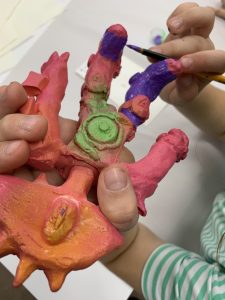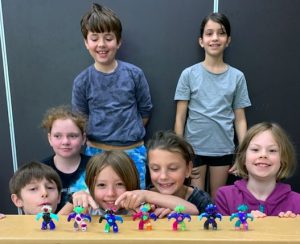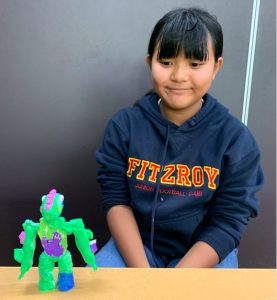Toy making
Artist in Residence Year 3-6, 2023
Cipta Croft-Cusworth, Toymaker and Puppeteer, commenced work as an artist in residence in Term 1 at Princes Hill Primary School. His work with Years 3-6 focused on toymaking.
Cipta has been making toys from very early age. When he came to Australia from Indonesia he hoped to create a toymaking community. Since being in Australia he has set up over 30 toy related events and gallery shows, build a community of over 60 toymakers and set up to toy stores voted “must see” places in Melbourne.
Cipta gave a presentation about the toys he has made to inspire the students to make their own toys. He explained that he makes toys for the joy of others.
“Toys have moved into the realm of art.”
Cipta wants to make people question what other realm toys can belong to such as the realm of art and collectibles. Toys have now become more far-reaching than just the children’s market; they form part of everyday creativity and art.
Cipta has worked with leading toy making companies such as Matel (Bobby and Hotwheels), Sanrio (Hello Kitty), DC (Batman, Superman), Spaster and Zuru to name a few. Before he was a toymaker his job was designing theme parks in Indonesia which was kind of like designing giant toys you can ride. He developed his own toy company called GGNW Toys in 2005 and also opened toy stores in Melbourne and Jakarta. His toy store in Melbourne is called “This Is Not a Toy Store.” When asked why it’s called this he replied, “True, everything in our shop is a toy… But it’s also art. It’s also a piece of Melbourne history. It’s also something magical that cannot be defined as just a toy. We are merchants of dreams.”
There are many ways to make toys. Cipta shared his skills in moulded resin toy making, launching a whole school Wellbeing Inquiry. These toys were then used to develop characters with a storytelling focus with the writer in residence in Term 2. Making toys is about character design. If you have an interesting toy, you can create an interesting character and this in turn opens the possibility for interesting stories.
WEEK 1
BRAINSTORMING, IDEAS AND SCULPTING
This week the children explored ideas to make their own figurines and action figures. Figurines are non-articulated and don’t move. Action figures are articulated and move. The latter are often bought in toy stores. In today’s workshop, we combined the action figure and figurine models. To give us some idea of what a figure is like, Cipta showed us a deconstructed action figure. This is an action figure when it’s broken up. We examined the parts. These parts consist of a base, a head, a body, arms and legs. He explained how you can change the character of a figure by creating different details.
Each student was allocated a body part to explore such as an arm, leg, body or head. They created limbs from plasticine. Students experimented with combining their designs into figurines. The idea was to work collaboratively and create something together.
Cipta explained a few techniques involved in making each body part. Smoothing out the joins between two parts, using the tools or fingers was important. Students used a range of clay tools to create details. Cipta explained that when we bring the parts together scale is a consideration. It is important to keep each body part approximately the same size to accommodate each part as belonging to a whole.
Next week students will pour silicon into the moulds of their plasticine limbs to create a series of parts. Students will be able to bring these parts together. This is known as a mash up. When all these separate parts are brought together in a number of variations there will be a range of different figures.
“I have learnt that if you put things or pieces together that don’t really match, they can be really cool.” Arabella
WEEK 2
MOULD MAKING, CASTING AND ASSEMBLY
During the week, Cipta created the moulds for each of the students’ plasticine limbs and then cast them.
Cipta demonstrated to the students the process he used to make moulds and then allowed each student to choose the parts they needed to use for their final creation. They poured silicon into the moulds.
“I was fascinated by the mixing of the silicon. I liked the way the silicon feels. It was good to find out about new processes. It has been inspiration to be able to use a new medium of expression.” Charlotte
“I was most impressed by the silicon mould making stage in the process of toymaking, and I was wondering whether there were technical things that happened like bubbles in it.” Isiah
The difference between what Cipta does and toys that are made in a factory is that the toys that Cipta makes are limited editions and very individual artworks. This process demonstrates how toys can be art.
“I never knew that toymaking could be so creative, and for the first time, I am able to show that I am good at art.” Ella
After all the characters were assembled, Cipta took a photo of each of the final designs, and then the students named their characters.
They then brainstormed ideas for colours and the final decoration. They considered each section of the toy and how they would paint them. They also shared stories about each of the characters based on the names and character traits of each. These stories were amazing and were often drawn from existing legends and stories and expanded and embellished with imaginative detail.
WEEK 3
Cipta brought in the moulded resin figures created during the week for the students to paint. Cipta had spray painted the base colour off campus and this week the students focused on creating details on the surface of these figures. Students used professional acrylic paints to create the details. They made sure to wash the brushes and dry them carefully in between colour changes.
Cipta explained that these figures are unique; made and designed by the students, and then produced in a factory ready for the final stage of detailed painting. This is where the customisation and individual makers mark is evident on each toy.
Students carefully and thoughtfully painted their figures, focusing on highlighting details, making sure the paint didn’t overlap, and also making sure the paint didn’t get on clothes. They thought about who their character was and what colours suited the character. There were many things to consider in this fine and detailed part of the process.
“It’s basically like a pop of colour, all of them look different in their own way.” Hattie
When the children saw their figures completed, the joy was evident. It has been an amazing journey – exploring a process and seeing a creative idea through to a tangible conclusion.
“They’re very colourful and I love every one because we picked up what we wanted, and that helped us to create something that came to life through us.” Eva
“They all look so different, even though they have the same parts. They have different colours, and they seem to be an add on (or extension) of yourself.” Maggie
WEEK 4
PAINTING AND FINISHING THE FIGURES
Cipta designed and sculpted a small figure inspired by the work of the children. He made multiple copies of this figure and gave these to the children so they would have a memento to take home as a record of the residency.
The children contemplated the colour palette of their mini figure and then painted them.
This was the final workshop of the residency and students reflected on what this residency meant to them:
“I feel like it’s been interesting. I’ve learnt a lot of new stuff about how to make a figurine, how to pay attention to detail, and to create stuff that is first designed in plasticine and then made into final sculptures. I have felt that I have made a big difference to the school by sharing with my classmates on what to do.” Flynn
“I was really interested in the process we went through to make the choice and the outcomes, that there were so many different toys.” Abdullah
“All the steps have been pretty easy, but have also been really lots of fun. I thought it would be more challenging, making the figures, but as it turned out, the steps were relatively easy. So, I have learnt that I could attempt it on my own.” Hattie
“I’ve learnt a lot about what Cipta has taught us and I’ve learnt to keep going even if I think I’m finished. That’s called refining our work.” Aaliyah
“The workshop has changed my aspect of toys. Sometimes you think of toys as mass produced, but now I know that toys can be art.” Huon
“I used to think the toys are just plastic things and now I am thinking that I want more because I know how they are made now. So, when my mum says no more toys! I will be able to make my own.” Arabella
“In the first week, I thought it was fun because we were creating our own body parts in our own style and it was very interesting thinking about what would happen when we combine all these body parts, and then in week 2, we assembled our characters and we also got to choose the base character. In week 3, we painted our characters with lots of detail and this week we did the finishing, touches and painted our own mini character to take home.” Arlo
“It was fascinating seeing all the ideas of everyone when we were designing the figures. When I got stuck, I got inspiration from all the other ideas that everyone had when we made the parts.” Olivia
There were many discussions about the design process and students also referred to their original work for inspiration when they painted the smaller figures. After painting the figures, last week, students felt that they had more experience painting this week. They felt able to focus more on details this week. We discussed choice of colour and how we often use colours that we know are great together but we also use our knowledge of the colour wheel to help us in our choice of colour and discussed the role of pattern when painting. We also discussed how pattern can be highlighted using the marks made from the moulding process.
The painting has been the favourite part of the process. Students felt that the most creative parts for them when they sculpted the figure parts and painted the final models.
The process that Cipta shared with us takes time. It is not just about making a toy, but following a process to make the toy.
“It has been a great experience and I’m very happy to have got this to do this, and it’s a great gift learning to make art.” Charlotte
“I have learnt how much effort it takes to make a toy.” Jess









